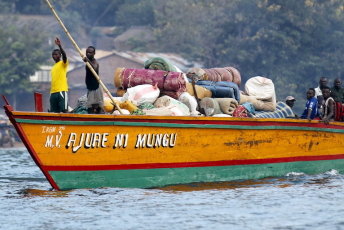Numerous obstacles are impeding the successful prosecution of sandalwood traffickers in Kenya. These include legal loopholes, overlapping jurisdictions, the application of multiple laws, a lack of coordination between key regulatory agencies and linkages between criminal networks and criminal justice officials.
The situation is exacerbated by inconsistencies in the legal approach to sandalwood trafficking across East Africa. In 2004, the Kenya Wildlife Service arrested 179 sandalwood traffickers and confiscated 180 000 kg of harvested sandalwood. There are, however, no records of successful prosecution for these crimes. In 2009, sandalwood traffickers used loopholes in Kenyan conservation laws to argue that sandalwood products confiscated in Kenya were actually products of Uganda en route to Tanzania. The court released the accused, Jane Nyambura Njunge, and returned the confiscated sandalwood to her.
More recently David Njoroge, Paul Njeru Mwai and Daniel Kibe Mboch were arrested in September 2019 with 11 tonnes of sandalwood worth US$397 830 (KES 44 million). They were initially charged under section 92 (2) of the Wildlife Conservation and Management Act of 2013 (being in unlawful possession of endangered species), which carries a seven-year prison sentence without the option of a fine. However the prosecutor substituted the initial charge with ‘removing forest produce without a permit,’ allowing for a lesser penalty, and each was fined US$452 (KES 50 000).
Similarly, Stephen Mungai Wanjiru was charged in January 2020 with being in possession of 700 kg of sandalwood contrary to section 92 (2) of the 2013 Act. During the prosecution, he was acquitted by the trial magistrate under section 215 of the Criminal Procedure Code, which gives a magistrate the power to convict or acquit suspects. The vehicle used by the accused to transport sandalwood was ordered to be released to the owner.
The mishandling of confiscated sandalwood exhibits across multiple agencies contributes to the collapse of many criminal cases. Jeff Okeyo of the Kenya Forest Service told ENACT that traffickers often stole confiscated sandalwood from police and Kenya Forest Service yards.
This was confirmed by Wesley Kipkazi, an officer based at the Lusaka Agreement Task Force secretariat, who pointed out that confiscated sandalwood was often not securely stored at police stations that lack proper exhibit management storage facilities. Poor storage has led to the destruction of exhibits as well as their theft from police stations and Kenya Forest Service yards. This again contributes to the failure of court cases.
Inconsistent policies add to these challenges, inhibiting law enforcement from targeting and prosecuting sandalwood traffickers. For instance, while the sandalwood tree is treated as a forest product under the custody of the Kenya Forest Service, it grows mainly in game parks governed under the Wildlife Conservation and Management Act of 2013.
Kenyan sandalwood is also illegally transported to Uganda for repackaging as a Ugandan product and transportation through the port of Mombasa. This is because trading in sandalwood is not against the law in Uganda.
Katto Wambua, a senior criminal justice adviser at Space for Giants, told ENACT that Kenyan sandalwood used to be transported to the Sky Beam factory in Tororo, Uganda, for semi-processing until 2017 when the factory closed. Wambua argues that the Sky Beam factory on the Kenya-Uganda border created a ready market for Kenyan sandalwood. The wood was trafficked by cross-border criminal networks that included brokers, smugglers and border security officials on both sides of the border.
To complicate matters further, sandalwood is protected by law within Tanzania, but imports are legal as long as they are accompanied by a valid permit. Tanzanian law treats sandalwood trafficking as an economic crime. Wambua explains that this attracts a punishment and sentencing model based on the intended use of the confiscated sandalwood, allowing perpetrators leeway to claim that the sandalwood is intended to be used as firewood, which attracts a lesser sentence. This permutation further facilitates the illegal trade in sandalwood sourced from Kenya to Tanzania and Uganda.
Furthermore, business protocols within the East African Community – which were aimed at facilitating ease of business in the region – have been exploited by sandalwood traffickers. In many cases, traffickers rely on the fact that sandalwood packaged in Uganda and sealed by the Uganda Revenue Authority is not inspected by the Kenya Revenue Authority at the Port of Mombasa on its way to international markets in India, the Arabian Gulf and China.
The evidence of weak law enforcement and disparate application of the laws in Kenya, as well as divergent regulations regionally demonstrate an advantageous context for sandalwood trafficking to flourish. Laws and regulations in Kenya that are mutually reinforcing to reducing trafficking and ensure appropriate sanctions are likely to facilitate the protection of the sandalwood tree. Enforcement of the Wildlife Conservation and Management Act of 2013 is key.
Multi-agency intelligence gathering and investigations of sandalwood trafficking networks and illicit markets would contribute to comprehensive evidence collection and support the prosecution of sandalwood traffickers in Kenyan courts. This approach would enable authorities to more easily identify patterns of operations, routes and financial flows that form part of criminal networks.
When combined with regional agreements, East African state responses will be in a stronger position to close many loopholes that allow traffickers to transport and transfer sandalwood from Kenya to the region. Developing these in line with the Convention on International Trade in Endangered Species of Wild Fauna and Flora (CITES) with be an important first step.
Along with this, the multi-agency approach among East African states, along trading routes and at ports is imperative. Here border control, intelligence, police, and wildlife and forest authorities in the region would provide for singular, coherent criminal justice response that would reduce the ambiguity from which criminals currently benefit.
A necessary first step is for authorities to recognise these inconsistencies and then jointly find feasible solutions for this life sustaining tree that is part of East Africa’s cultural heritage.
Willis Okumu, Senior Researcher – East and Horn of Africa, ENACT Project, ISS







